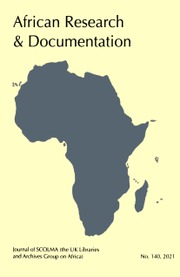No CrossRef data available.
Article contents
Googling African History: Connecting Students to Africa’s Past With Digital Primary Sources
Published online by Cambridge University Press: 25 April 2022
Extract
Primary sources are evidence created at the time of an event or after by participants or observers. Examples may include text – memoirs, letters, manuscripts, diaries, newspapers; images – photographs and posters; audio or video recordings – oral histories and speeches; artifacts – furniture, pottery, and cultural objects. These are the raw materials historians use to meaningfully reconstruct the past. These along with previous interpretations by other historians or secondary sources are the tools needed to perform historical research. This paper examines the intersection of African primary sources, new digital technologies and new active learning teaching methods within the teaching of African history. It discusses new approaches to teaching and learning history in undergraduate programs in the United States using both tangible and digital primary sources.
Information
- Type
- Other Articles
- Information
- Copyright
- Copyright © African Research & Documentation 2019

